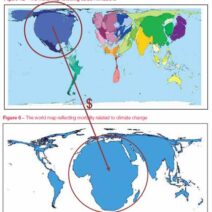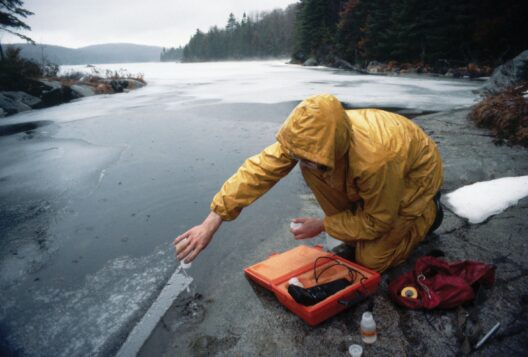Global warming is often portrayed as a creature lurking in the shadows, a formidable beast fed by the emissions that escape from the chimneys of our industrial age. However, the reality is that this creature is not mere smoke and soot; it is a complex amalgamation of chemicals, a cocktail of substances that do more than just contribute to the air we breathe. They are the hidden culprits, the insidious agents in our fight against climate change.
At the heart of this matter lies the greenhouse effect, a natural phenomenon that warms the Earth. Much like a greenhouse trapping heat, greenhouse gases—including carbon dioxide (CO2), methane (CH4), and nitrous oxide (N2O)—dance gracefully around our atmosphere, catching the sun’s warmth. However, as human activity escalates this graceful dance transforms into a chaotic ballet, propelling us toward a calamitous climax.
Carbon dioxide is often heralded as the primary villain in our climatic narrative. Its production is ubiquitous, stemming from fossil fuel combustion, deforestation, and various industrial processes. Each breath of CO2 we release is like a drop in a bucket, but soon that bucket overflows. The burning of coal, oil, and natural gas for energy feeds this insatiable bucket, causing atmospheric concentrations to rise relentlessly.
But what lies beneath the surface of carbon dioxide? Beneath this glaring figure lies a host of other chemicals, each with their sinister characteristics and unique contributions to global warming. One of the most potent among these is methane. Methane is remarkable for its efficiency as a greenhouse agent; it is profoundly more effective than CO2 in warming the planet over a short time frame. While CO2 persists for decades to centuries in the atmosphere, methane’s potency lasts for roughly two decades. During this time, it can have more than 80 times the warming potential of carbon dioxide, transforming it from a simple gas into a formidable force in climate change.
The origins of methane are diverse, flowing from both natural and anthropogenic sources. Agriculture plays a pivotal role, with livestock and rice paddies being major contributors. The digestion of feed by cows releases significant amounts of this gas. Compounded by the decay of organic matter in wetlands and landfills, methane’s role only gains gravity, as each source adds layers to the existing problem.
Another overlooked player in this chemical opera is nitrous oxide. Even though it is released in much smaller quantities compared to carbon dioxide and methane, its global warming potential is 298 times greater than that of CO2 over a century. Agriculture is again a leading contributor, particularly through the application of synthetic fertilizers. Each application injects this potent gas into our atmosphere, transforming lush fields into vessels of climate degradation.
The realm of hydrofluorocarbons (HFCs) adds yet another dimension to our increasing atmospheric burden. Originally deemed a solution to ozone depletion (as replacements for ozone-depleting substances), HFCs now appear as double agents in the climate crisis. Their warming potential can be thousands of times greater than that of CO2, and they are released from air conditioning systems, refrigeration, and aerosol propellants. Despite their initial promise, we find ourselves faced with new battlegrounds of environmental challenges.
The convoluted web of chemical contributions extends into the realm of black carbon. Comprising tiny soot particles from incomplete combustion of fossil fuels and biomass, black carbon not only contributes to global warming but also impacts air quality and human health. Each particle, akin to a tiny heat-seeking missile, has the capability to absorb sunlight and warmth, exacerbating the overall heating of our planet. It settles over snow and ice, reducing their reflectivity and accelerating melting—yet another insidious cycle of warming.
As we peel back the layers of this complex web, it becomes evident that solutions cannot solely rely on reducing carbon emissions. Addressing the multifaceted nature of climate chemistry compels us to broaden our scope. Innovations such as methane capture technologies within the agricultural sector can mitigate emissions. Here, the power of circularity within agricultural practices becomes essential. By harnessing biogas from manure, farmers can transform waste into energy, thereby addressing methane emissions at the source.
Moreover, the aerial brigade combating global warming can benefit from advancements in climate-friendly refrigerants that replace harmful HFCs. The emergence of natural alternatives, including hydrocarbons and ammonia, provides both an opportunity and an obligation to rethink cooling technologies. Transitioning to these less harmful chemicals embodies a proactive approach to mitigating climate change.
Education and awareness play crucial roles in disseminating knowledge about less-observable contributors to global warming. The fight against climate change demands a multifaceted strategy that encompasses reductions in greenhouse gases, innovative solutions, and a commitment to sustainability. We must hold accountable not only industries but also the behaviors that sustain these carbon-based practices.
As we confront this intricate tapestry of chemical drivers, it becomes clear that each thread matters. Whether it is the heavy weight of carbon dioxide, the potent dance of methane, or the deceptive allure of HFCs, understanding their unique roles is crucial in our environmental narrative. The future hinges not only on our capacity to recognize these hidden culprits but also on our willingness to combat them collaboratively, forging a path toward a sustainable world.






